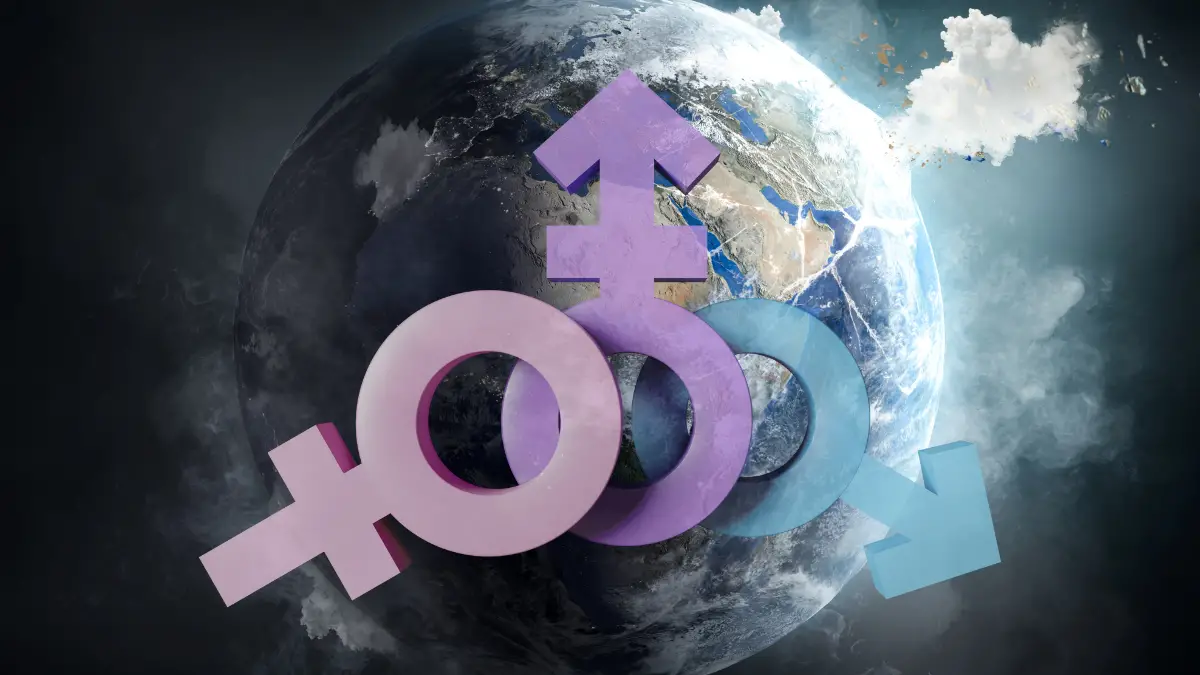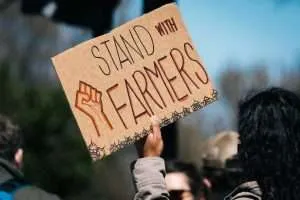Climate change from a sociological perspective is viewed as an emerging global socio-political issue and one of the greatest ecological crises in the twenty-first century driven by both anthropocentrism (i.e., due to the activities of human species for the fulfillment of their needs) and by capitalist patriarchy (meaning a close relationship between two forms of systemic oppressions namely capitalism and patriarchy that mutually reinforce each other thereby influencing the human and nature relations).
Climate change is all pervasive and everyone is affected, however, the nature of impact varies considerably for each group based on social factors, social norms and cultural values. In this backdrop, climate change accounts for the majority of gendered vulnerabilities that gender minorities experience, namely the women and transgender communities. The social ramifications of climate change are primarily manifested in the nature of its gendered impact.
Gendered Vulnerabilities to Climate Change in India: An Overview
It is essential to understand that climate change is not merely a natural calamity, it is a crude indicator of socio-economic, socio-cultural, socio-political and spatial vulnerabilities faced by women and transgender groups. The following is a review of gendered vulnerabilities to climate change in India from the excerpts of diverse research published on the nexus between climate change and gender.
- Firstly, women disproportionately face the disadvantages of climate change as culturally women are confined to social roles and responsibilities that involves their labour expenditure in climate-sensitive work such as agriculture, water, fuel and fodder collection for their livelihood.
- Secondly, women’s expenditure of reproductive labour namely child-birth and child-rearing in the domestic spaces involve women’s full dependence on natural resources for their survival.
- Thirdly, women depend on natural resources for the vital supply of raw materials in order to sustain the household.
- Fourthly, women are most adversely affected by climate change. Adverse ecological impact on women affects child bearing, child-rearing and other reproductive care responsibilities and hence can perpetuate the problem through intergenerational transmission of environmental inequities.
- Fifthly, women bear the cumulative effect of climate change vulnerabilities and their structural vulnerabilities are exacerbated due to the inter-play of demographic factors such as gender, caste, class and ethnicity.
- Sixthly, Climate change induced migration referring to forced migration of groups of people from their home region due to sudden or long-term changes in their immediate and local biophysical environment results in internal displacement of groups and communities of people within the geographical boundaries of the state, nation-state or movement of people to different parts of the world because of the environmental stressor. Climate change induced migration in India has resulted in the social phenomenon of ‘left-behind wives and children’ and ‘destituted wives’ with husbands engaging in bigamous marriages in places of destination. Polygamous marriages are also prevalent in India where men marry many women so that women can fulfill the function of fetching water for household maintenance as reported in Scroll in 2015.
- Seventh, transgender communities largely experience the brutality of climate change subjecting them to climate shock and decreased climate resilience as the majority of them face homelessness due to social stigma associated with their identities. Their deplorable condition of homelessness is exacerbated by the severity of climate change such as increasing temperatures, rainfall and natural calamities.
- Eighth, Informal women workers in the informal labor market in India such as construction workers experience marginalization due to erratic labor patterns and non-availability of work during monsoon seasons. In such cases, women construction workers due to adverse effects of climate change work in extreme conditions of heat with increasing susceptibility to chronic diseases. The non-availability of work during monsoon seasons pushes women construction workers to margins of poverty. Home-based women workers on the other hand live in precarious living conditions often subjected to spatial inequality. The gendered vulnerabilities arising from the exploitation in home-based work is exacerbated with adverse climatic conditions such as rise in temperature making the home too hot to work.
- Ninth, during a natural or a man-made disaster, the transgender communities mostly located in the slums or homeless are adversely affected by the disaster. Also, sexual minorities face isolation due to systemic bias and violence with absolute lack of support systems during times of climate crises. These communities face higher risk of homelessness, food insecurity and health care insecurity due to climate change.
- Tenth, transgender communities also face the risk of lack of accessibility to affordable health care, emergency shelters during times of climate crises and disasters as majority of them live in poverty and marginalization.
The Significance of Gender-Transformative Climate Action in India
Men, women and transgender communities experience the impact of climate change differently. The differential vulnerabilities faced by these communities indicate the need for gender-transformative climate action ensuring that the needs of different gender groups are met. Extending from the needs-based continuum the emphasis is on empowerment of women, transgender minorities for full participation in climate action through decision-making, planning and implementation. Integrating the Gender and Development approach into climate action will facilitate the formulation of gender-transformative climate action by drawing on the indicators from practical gender needs and strategic gender interests.
Gender planning in the context of gender and development for policy formulation involves understanding not only the differences in gender but also understanding the nature of systemic inequalities. Mainstreaming gender into gender planning from the Gender and Development perspective involves ensuring equal outcomes for all in the gender spectrum
A paradigmatic shift from women in development approach to gender and development approach shows how WID focussed on integrating women into development through women’s full participation in the productive sphere and viewed women as merely passive recipients of development and accepted the traditional hegemonic structures of power. However, gender and development approach focus on understanding the systemic causes of gendered oppression and views women in relation to men as active agents of their own development. The practical gender needs and strategic gender interests are taken into consideration for formulation of gender-transformative policies that seek to change the gendered positioning of women by addressing the systemic inequalities rather than meeting only the material needs. Hence, gender transformative climate action integrates the Gender and Development perspective and focuses on how gender minorities can act as agents of climate action through their participation and leadership in climate resilience namely natural resource management, disaster preparedness, sustainable livelihood options, reducing the green-house gas emissions and creating a low-carbon economy.
The G20 Presidency has placed due emphasis on climate action and there is a need to review the existing state level action plans on climate change to facilitate the passage of gender transformative climate action in India.
It is essential that our national and state level climate policies acknowledge and recognize gendered vulnerabilities and integrate gender in climate change adaptation and climate change mitigation in their climate policy documents and climate action initiatives. Gender-blind climate policies are masculinized and exclude women. Both gender-blind and gender-neutral climate policies do not recognize gendered vulnerabilities.
Gender-specific climate policy focuses only on practical gender needs that are material needs of women. It views women as vulnerable victims of climate change. Gender-sensitive climate policy understands the processes that shape gender relations situating women as a group capable for adaptation to climate change and finally gender-transformative climate policy focuses on the need to restructure the existing distribution of resources for establishing equitable gender relations based on strategic gender interests such as freedom of choice, access to credit, land rights and access to control over natural resources and abolition of gendered division of labor. For instance, Tamil Nadu’s climate action plan is gender-specific meaning it identifies women as victims of climate change and Uttarakhand has evolved to be more gender-transformative in its climate policy action plan meaning women are identified as active agents in climate action plan.
Women as ‘Active Agents’ in Climate Action
Women are closely connected to nature by interacting with the environment for fulfilling the everyday subsistence needs of the household. Empirical data supports that women often bear the responsibility of feeding and caring for their children while maintaining a household. Women also have extensive knowledge on subsistence agriculture. For eg-Domestication of plants was developed by women in the Third world. These are key indicators to situate women as active agents in climate action. Hence, there is an immediate need to include participation of women and also transgender communities in inclusive climate action plan in India
India as a party to the United Nations Framework Convention on Climate Change (UNFCCC) elevated through the Paris agreement have increasingly recognised that “gender equality and the effective participation of women is important for effective action on all aspects of climate change” (UNFCCC, 2011).
In this context from the perspective of gender and development, the following are participatory strategies for gender-transformative climate action to be institutionalized at the national and state level
Green Jobs and Green Economy
From the key indicators of COP27 27th United Nations Climate Change Conference that focuses on promoting green jobs that aim at restoring natural resources and environmental preservation can challenge climate crises by increasing women’s participation in the green labor market such as the green construction sector and clean transportation. Women take up conventional jobs in the construction sector such as carrying bricks, cement and fetching water defined by traditional gender norms. With the integration of green jobs in manufacturing, construction and service sector women’s knowledge on natural resource management and recycling can be used for energy efficient and environmentally friendly construction practices. It is essential to note that our national government’s central focus is on establishing a ‘green economy’ that is resonated in the 2023 national budget with a clear emphasis on sustainable development and inclusion of gender in nationally determined contributions of climate action plan.
Climate and Energy Entrepreneurs
Fostering partnerships with government and private stakeholders, women and transgender communities can be empowered for starting climate start-ups that focus on renewable energy resources such as solar lighting, solar lamps and cookstoves as sustainable and affordable solutions for rural communities. The Sakhi initiative has already reached widespread attention as a clean-energy entrepreneurship in India. Women as primary household managers can make informed decisions in the usage of clean fuel for cooking and reduce the impact of gendered health vulnerabilities that emerge from inhaling unclean fuel during cooking. Women can be endorsers of marketing messages targeted at usage of clean fuel.
Climate Action Social Enterprises
The blended value of social and economic value in social entrepreneurship is a potential for creating a climate resilient sustainable development in developing countries like India. Social enterprises start-ups by gender minorities are another alternative in climate action for promoting eco-friendly products, clean energy products and designing eco-friendly inclusive spaces for all.
Conclusion
Gender and climate action in India requires a multi-stakeholder approach that integrates the institutional networking of government, private players in the market economy, philanthropists, academia and civil society organizations to ensure gender mainstreaming in climate action
Read: Migration Research with Social Science Insights
References:
- Scroll (2015), Some Indian Farmers are marrying extra wives to literally carry their water for them. Some Indian farmers are marrying extra wives to literally carry their water for them (scroll.in)
- UNFCCC (2011), Introduction to Gender and Climate Change. Introduction to Gender and Climate Change | UNFCCC







